Being a dog owner can be stressful, and dog nail bleeding is no exception. It’s important to know how to handle this at home. This way, you can give your pet the care they need right away.
I’ll show you how to manage nail bleeding effectively. This ensures your pet gets the best care possible.
Key Takeaways
- Understanding the causes of dog nail bleeding
- Immediate steps to stop the bleeding
- Home remedies for nail care
- Preventing future nail bleeding incidents
- When to seek veterinary care
Understanding Why Dog Nails Bleed
It’s important to know why dog nails bleed. This knowledge helps in managing and preventing the issue. There are several reasons why dog nails might bleed, and finding the cause is essential for the right treatment.
Common Causes of Nail Bleeding
One main reason for dog nail bleeding is cutting the nail too short. This is called trimming too close to the quick. The quick is a sensitive part of the nail with nerves and blood vessels. Cutting it can lead to a lot of bleeding.
Other reasons include:
- Nail injuries or trauma
- Infections or diseases affecting the nail
- Nail biting or chewing due to anxiety or boredom
For more detailed information on how to manage nail bleeding, you can visit PetMD’s guide on stopping dog nail.
How to Recognize Nail Bleeding
To spot nail bleeding, look for signs in your dog’s nails. If you see bleeding, your dog might:
| Signs | Description |
|---|---|
| Bleeding | Visible blood from the nail |
| Pain | Your dog may yelp or show discomfort |
| Swelling | The area around the nail may become swollen |
When to Seek Veterinary Help
While some nail bleeding can be handled at home, there are times when a vet is needed. If the bleeding doesn’t stop after 10-15 minutes of applying pressure, or if you see signs of infection, get help.
Also, if your dog shows pain or discomfort, like limping or avoiding the affected paw, see a vet.
Immediate Steps to Take
When your dog’s nail starts bleeding, act fast to reduce stress and prevent more harm. Stay calm and follow a step-by-step plan to stop the bleeding.
Calm Your Dog Down
First, calm your dog to avoid more stress or injury. Speak softly and pet them gently. Try using treats or a favorite toy to distract them.
Assess the Injury
After calming your dog, check the injury’s severity. Look at how fast the bleeding is and if there’s dirt in the nail. Knowing this helps you choose the right action. For more on assessing nail injuries, check this resource.
Gather Necessary Supplies
Get the right supplies to stop the bleeding. You’ll need styptic powder, flour, or cornstarch. Having these ready helps you act fast and right.
| Supply | Purpose |
|---|---|
| Styptic Powder | Stops bleeding quickly |
| Flour | Acts as a natural coagulant |
| Cornstarch | Helps to absorb blood and promote clotting |
By taking these immediate steps, you can manage your dog’s nail bleeding well. This ensures their comfort and safety.
DIY Home Remedies for Nail Bleeding
Several DIY remedies can stop dog nail bleeding effectively. These home remedies help dog owners manage the situation until they can get professional help.
Cornstarch Management
Cornstarch is a common household item that can stop dog nail bleeding. Apply a small amount directly to the bleeding nail. It absorbs the blood and promotes clotting.
You can mix cornstarch with a bit of water to make a paste. This paste sticks better to the nail.
Flour as a Natural Coagulant
Flour is another household item that stops dog nail bleeding. Apply a small amount of flour to the bleeding nail. It absorbs the blood and promotes clotting.
For more information on managing dog nail bleeding, visit this resource for expert advice.
Using Baking Soda
Baking soda is a versatile household item for stopping dog nail bleeding. Mix it with water to create a paste. Apply it to the bleeding nail.
The baking soda paste can neutralize the bleeding and promote healing.
It’s crucial to stay calm and act quickly when dealing with dog nail bleeding. Using these DIY remedies can stop the bleeding and prevent further complications.
Commercial Products for Nail Bleeding
Commercial products can quickly stop dog nail bleeding. They are made to help dog owners manage bleeding effectively. This gives them peace of mind and helps their pets feel better right away.
Styptic Powder Overview
Styptic powder is a top choice for stopping dog nail bleeding. It’s a mix of substances that constrict the nail and stop the bleeding. To use it, just dip the bleeding nail into the powder or apply it with a cotton swab.
Styptic powder is easy to find at pet stores and online. You can check out different options on Amazon. It’s simple to pick the right one for your dog.
Applying Styptic Pads
Styptic pads are also great for stopping nail bleeding. These pads have a styptic agent that stops bleeding fast. To use a styptic pad, just press it against the bleeding nail for a few seconds.
- Easy to use, even for nervous dog owners
- Portable and convenient for travel
- Effective for stopping bleeding quickly
Choosing the Right Product
When picking a product for dog nail bleeding, think about a few things:
- The severity of the bleeding
- The size and age of your dog
- Any sensitivities or allergies your dog may have
It’s smart to talk to your vet for advice on the best product for your dog.
Preventing Nail Bleeding in the Future
Keeping your dog’s nails trimmed is key to avoiding nail bleeding. It also helps keep their paws healthy. By cutting their nails right, you can prevent cuts and injuries.
Regular Nail Trimming Tips
Trimming your dog’s nails regularly is important. How often depends on their breed, age, and how active they are. Dogs that are more active or have longer nails need more trimming.
- Trim just the tip of the nail to avoid cutting the quick.
- Use a nail trimmer designed for your dog’s nail size and type.
- Gradually trim a little at a time, checking the nail for signs of the quick.
For more detailed guidance on stopping nail bleeding, you can visit Toegrips for additional tips and advice.
Choosing the Right Tools
The right tools are crucial for nail trimming. Here’s a comparison of popular nail trimming tools:
| Tool Type | Description | Best For |
|---|---|---|
| Scissor Clippers | Ideal for small to medium-sized dogs | Puppies or dogs with small nails |
| Guillotine Clippers | Easy to use and suitable for larger dogs | Dogs with thicker nails |
| Nail Grinders | Grind down nails to a safe length | Dogs with very hard or thick nails |
Understanding Your Dog’s Nail Anatomy
Knowing your dog’s nail anatomy is vital for safe trimming. The quick is a sensitive part of the nail. It contains nerves and blood vessels. Cutting the quick can hurt and cause bleeding.
To avoid this, it’s important to find the quick before trimming. For dogs with light-colored nails, the quick is easy to see as a pinkish area. For dogs with dark nails, it’s harder. You may need to trim small amounts at a time to avoid cutting too short.
Handling Nail Trimming Anxiety
It’s important to handle nail trimming anxiety for a stress-free grooming experience. Many dogs get very upset during nail trimming. This can be hard for both the dog and the owner.
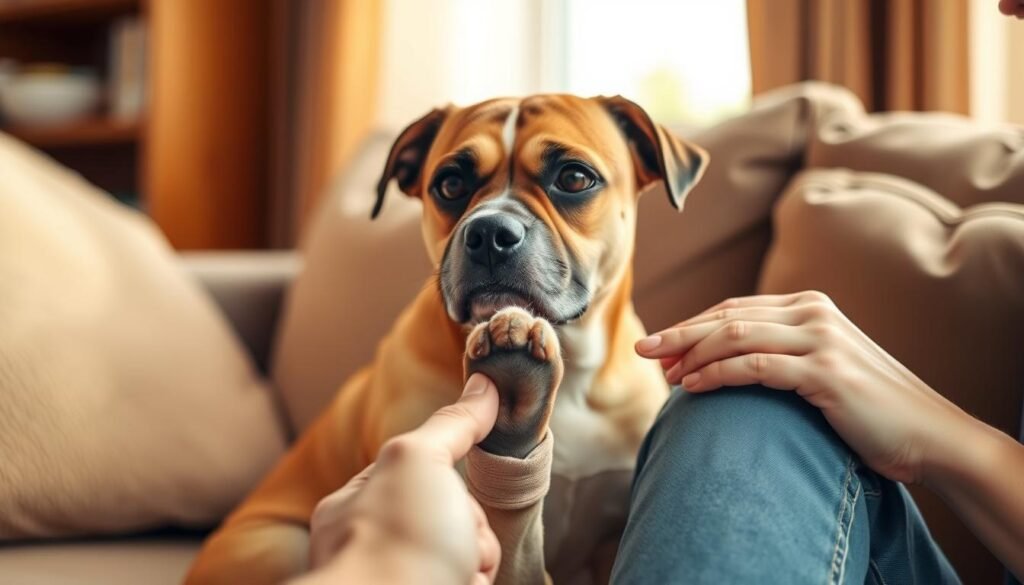
Tips for Comfortable Nail Trimming
To make nail trimming less stressful, create a comfortable environment. Pick a quiet, distraction-free spot where your dog feels safe. Using the right tools is also key; choose clippers that fit your dog’s size and nail type.
Introduce the nail clippers slowly to your dog. Let them sniff and explore at their own pace before trimming. Positive reinforcement with treats and praise can make it more enjoyable.
Desensitization Techniques
Desensitization helps dogs get used to nail trimming. Start by gently touching their paws and then introduce the clippers. Reward them with treats and praise for staying calm.
“Desensitization and counterconditioning can significantly reduce a dog’s stress during nail trimming by gradually exposing them to the process in a controlled manner.”
Keep doing this until your dog is okay with the clippers. Be patient and go at your dog’s pace to avoid more stress.
Positive Reinforcement Methods
Positive reinforcement makes nail trimming more pleasant. Reward your dog with treats, praise, and affection when they stay calm.
| Method | Description | Benefits |
|---|---|---|
| Treats | Reward your dog with their favorite treats | Encourages positive behavior |
| Praise | Verbal praise and affection | Builds trust and confidence |
| Playtime | Engage in play after nail trimming | Associates nail trimming with positive outcomes |
By using these techniques, you can reduce your dog’s anxiety. This makes nail trimming more enjoyable for both of you.
Aftercare for Injured Nails
It’s important to take good care of your dog’s injured nail to avoid infection and help it heal. After the bleeding stops, watch the nail closely. This helps prevent any further problems.
Observing the Injured Nail
Watch the injured nail for signs of infection like redness, swelling, or discharge. Also, notice if your dog is licking or chewing at the nail too much. This could mean they’re in pain or have an infection.
Signs to Watch For:
- Redness or swelling around the nail
- Discharge or pus
- Excessive licking or chewing
- Reluctance to walk or play
Preventing Infection
To stop infection, keep the injured nail clean and dry. Use an antibiotic ointment to help it heal and lower infection risk.
Tips for Preventing Infection:
- Clean the nail with mild soap and water
- Apply antibiotic ointment
- Keep the nail dry
When to Return to Normal Activities
Let your dog heal before they go back to normal activities. Avoid hard exercise or activities that might hurt the nail until it’s fully healed.
| Activity | Recommended Waiting Time |
|---|---|
| Strenuous Exercise | 3-5 days |
| Long Walks | 2-3 days |
| Playtime | 2-3 days |
If you’re not sure when to start normal activities again, talk to your vet. They can give you advice that’s right for your dog.
Signs of Complications to Watch For
It’s important to know the signs of complications after a dog’s nail bleeding. After fixing the immediate problem, watch your dog closely as they recover.
Discoloration or Swelling
Discoloration or swelling around the nail is a big warning sign. If the area turns red, swells, or changes color, it might mean an infection. Knowing how urgent dog nail issues are is key to acting fast.
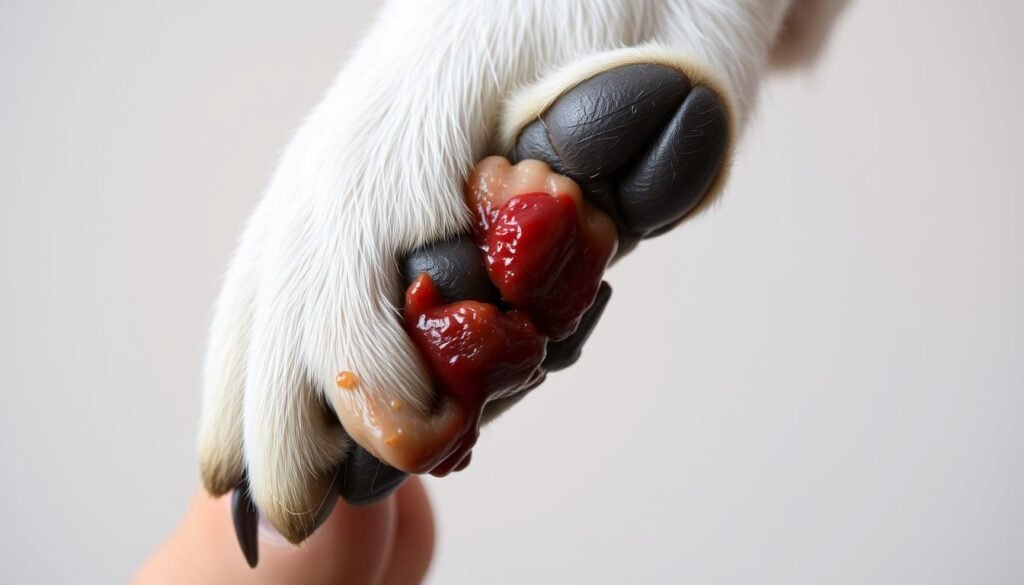
Excessive Licking or Chewing
Dogs might lick or chew their nails sometimes. But if they do it a lot, it could mean they’re in pain or have an infection. If your dog keeps going back to the injured nail, it’s a sign something’s wrong.
Reluctance to Walk or Play
If your dog doesn’t want to walk or play, they might be in pain. Watching how active they are and their mood is important after the injury.
| Signs | Possible Complications | Action |
|---|---|---|
| Discoloration or Swelling | Infection | Consult a veterinarian |
| Excessive Licking or Chewing | Discomfort or Infection | Monitor and consult if persists |
| Reluctance to Walk or Play | Pain or Discomfort | Provide a comfortable environment and consult a vet if necessary |
By watching for these signs early, you can make sure your dog gets the care they need to heal from a nail bleeding incident.
Seeking Veterinary Assistance
Dog owners need to know when to get vet help for nail bleeding. Some cases can be handled at home, but others need a vet’s care.
When Home Remedies Aren’t Enough
If your dog’s nail keeps bleeding after 10-15 minutes of home care, get vet help. Also, if you see signs of infection like redness or swelling, it’s time to see a vet.
Signs that indicate the need for veterinary assistance include:
- Persistent bleeding
- Visible signs of infection
- Nail damage or breakage
- Your dog showing signs of pain or discomfort
Vet Treatments for Nail Injuries
Vets offer many treatments for nail injuries. These include:
| Treatment | Description |
|---|---|
| Nail Trimming | Trimming the nail to prevent further irritation |
| Antibiotic Application | Applying antibiotics to prevent or treat infection |
| Bandaging | Wrapping the paw to protect the nail and promote healing |
Understanding Billing and Insurance
It’s key to know about vet billing and insurance. Most clinics have clear billing and accept many insurance plans. Talk to your vet about costs and insurance.
Tips for navigating veterinary billing:
- Ask about costs upfront
- Check if your insurance covers vet visits
- Consider pet insurance for future incidents
Being informed and prepared helps your dog get the care they need without financial stress.
Educating Yourself on Dog Care
As a dog owner, it’s key to keep learning about dog care. This helps you create a loving home for your pet. It also makes your bond with your dog stronger.
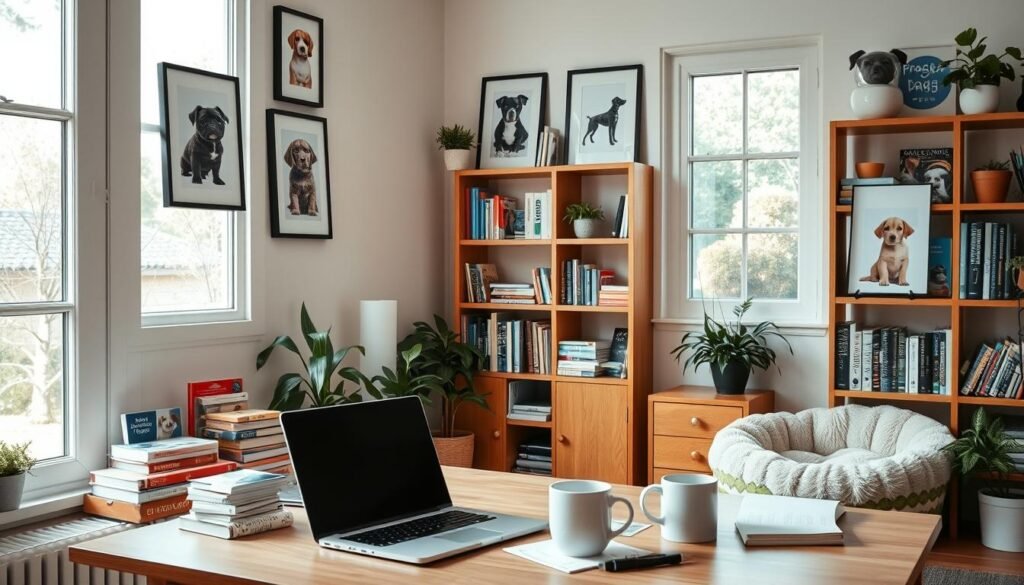
Resources for Dog Owners
There are many resources for dog owners to learn from. You can find online forums, local dog training classes, and more. Start with trusted websites and dog care blogs for info on health, behavior, and food.
Vets are also a great resource, offering advice and help. Dog training books and online courses can teach you about behavior and training.
Online Training Courses
Online training courses are popular for their ease and flexibility. Sites like Coursera, Udemy, and dog training websites offer courses. They cover everything from basic obedience to advanced training.
These courses are taught by experts. They use videos, interactive sessions, and downloads. Learning at your own pace lets you apply what you learn to your dog’s training.
Finding a Local Dog Trainer
Online resources are great, but a local dog trainer is also very helpful. They can help with behavior, give feedback, and tailor advice to your dog.
To find a good local trainer, ask friends, family, or your vet. Check online directories and reviews too. Look for trainers certified by groups like the Certification Council for Professional Dog Trainers (CCPDT).
“The right training can change your dog’s behavior and well-being,” says a famous dog trainer. “It’s about understanding your dog and working together for a better relationship.”
Creating a Safe Grooming Environment
Creating a safe grooming environment is key to reducing anxiety and making grooming smoother for you and your dog. A well-organized space ensures your dog’s safety and makes grooming more efficient.
Setting Up a Designated Grooming Space
To set up a grooming space, find a quiet area in your home with few distractions. This could be a bathroom corner, laundry room, or garage section. Make sure it’s well-lit and has a non-slip surface to prevent accidents.
I suggest using a grooming table or raised surface. It makes grooming easier without straining your back.
Tools and Supplies Checklist
Having the right tools and supplies within reach is crucial for a smooth grooming session. Here’s a basic checklist to get you started:
- Nail clippers or a nail grinder
- Styptic powder or a styptic pencil
- Grooming brush or comb
- Treats for positive reinforcement
- A comfortable, non-slip mat
Make sure all your tools are clean and in good condition. This prevents infections or injuries.
Maintaining a Stress-Free Atmosphere
Maintaining a stress-free atmosphere during grooming is vital for your dog’s comfort and safety. Keep grooming sessions short, which is important for puppies or dogs new to grooming. Use positive reinforcement like treats and praise to make grooming a positive experience.
Also, watch your dog’s body language. If they seem stressed or uncomfortable, it’s best to take a break and resume when they’re more relaxed.
Conclusion: Keeping Your Dog Safe and Healthy
As a dog owner, being ready for unexpected situations like nail bleeding is key. Understanding the causes and knowing how to react helps keep your dog safe and healthy. Having the right supplies is also important.
Nail Care Essentials
Remember, regular nail trimming and using the right tools are crucial. A safe grooming environment is also essential. Knowing when to seek vet help is important for your dog’s health.
Empowering Dog Owners
Staying informed about dog care is vital for responsible owners. This ensures your dog is happy and healthy. Regular vet visits are also important for your dog’s well-being.
Regular Check-Ups Matter
Regular vet visits are key to keeping your dog safe and healthy. They help catch issues early, preventing bigger problems. By focusing on your dog’s health, you’ll have a strong bond with them.


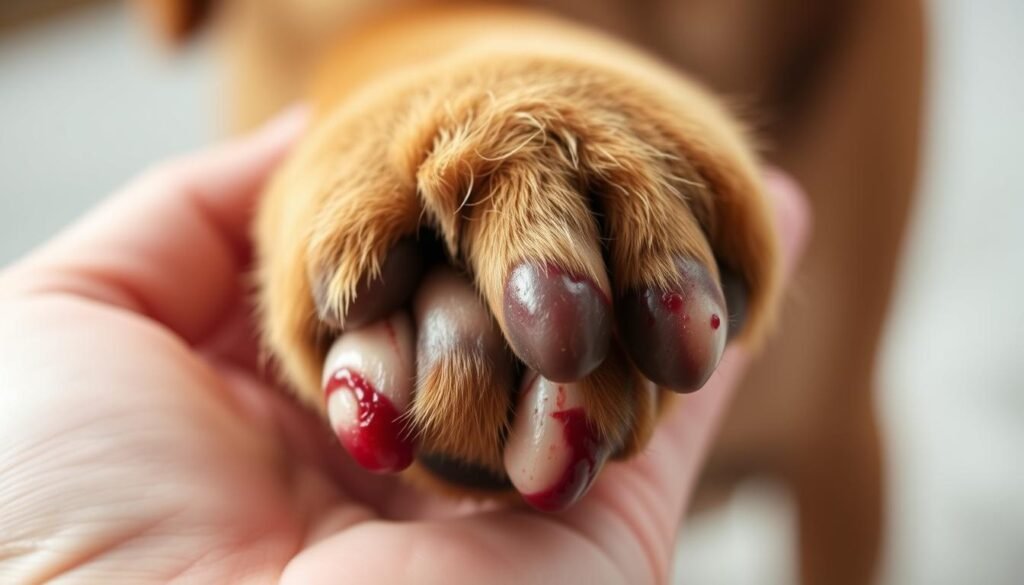
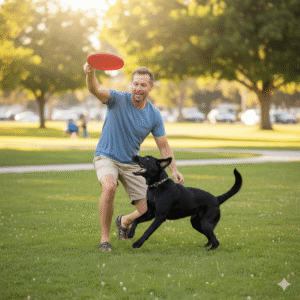



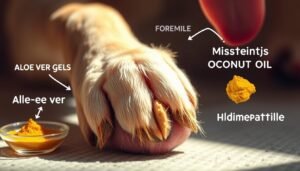
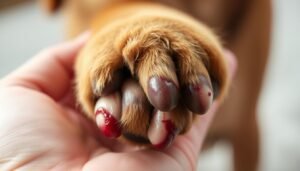




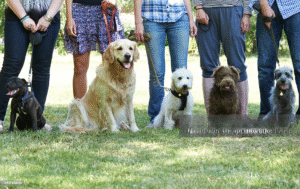








One Response